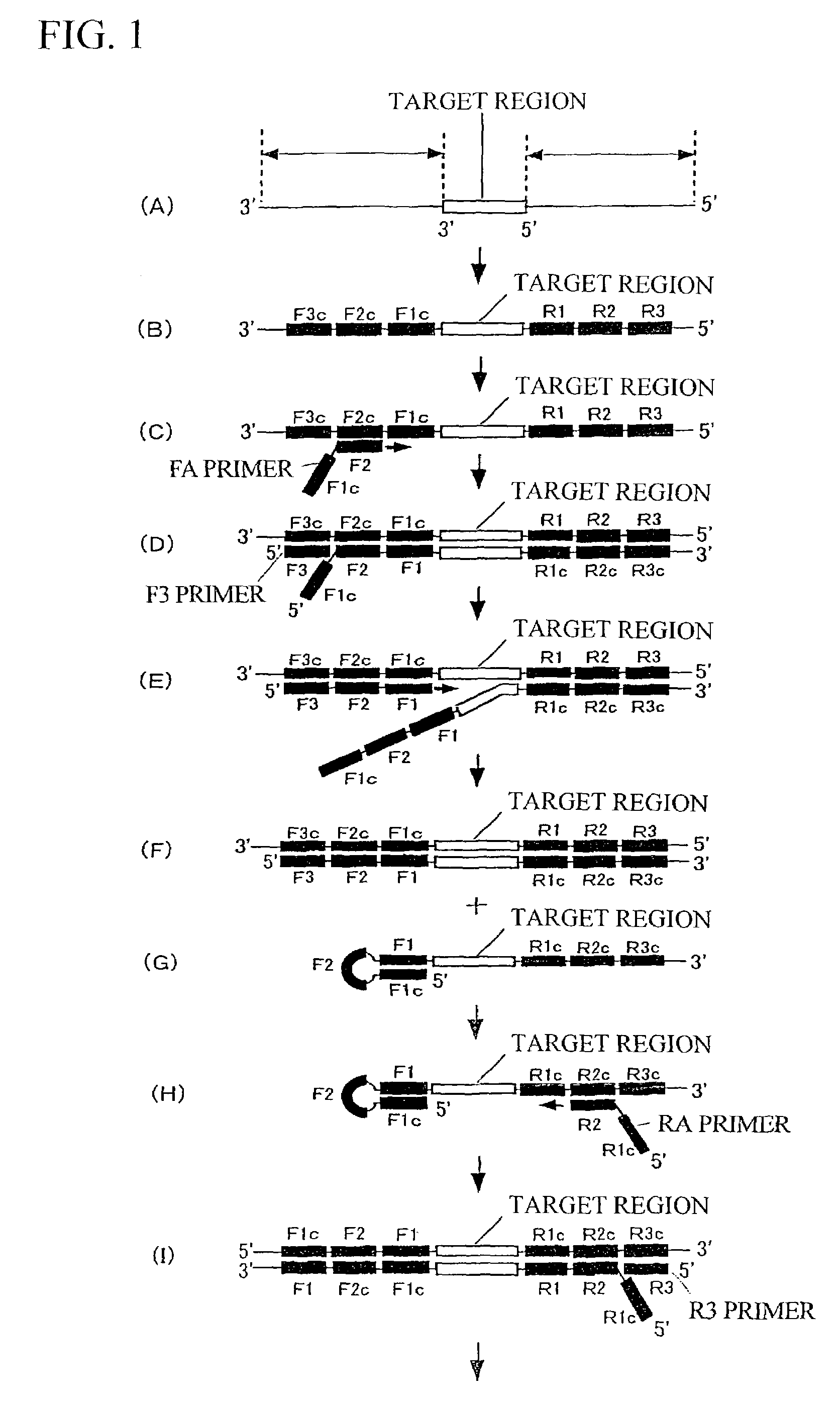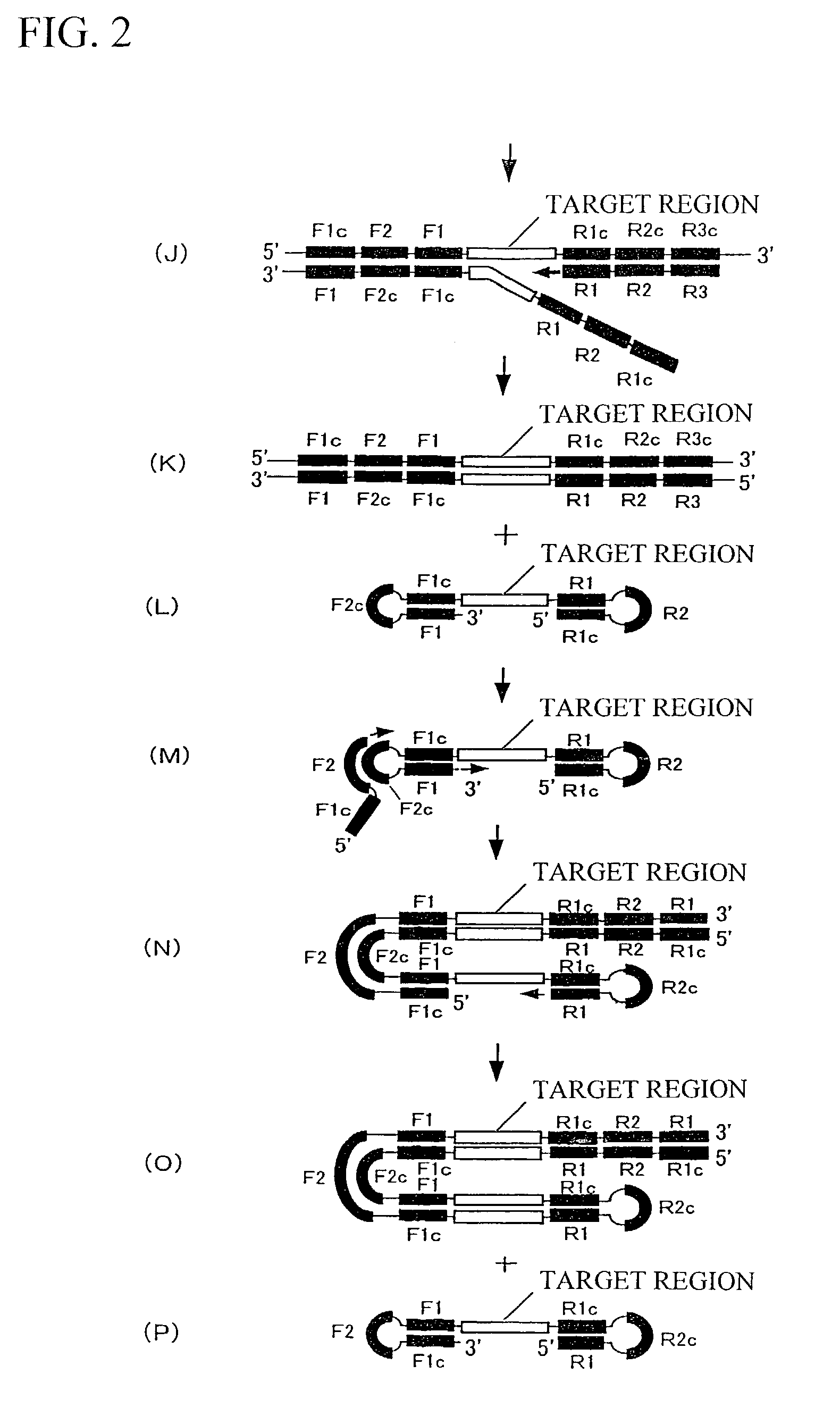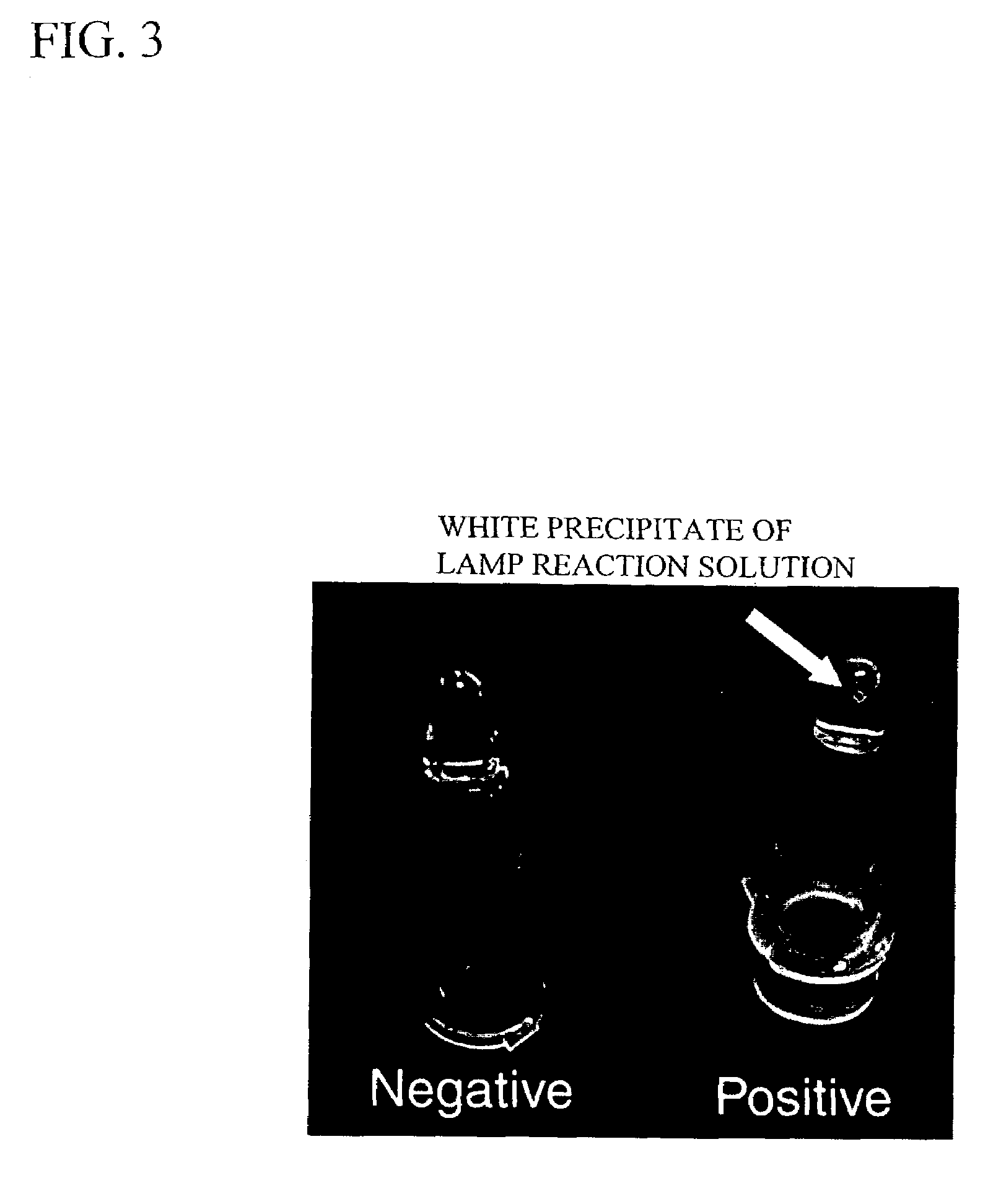Method for detecting product of nucleic acid synthesizing reaction
a nucleic acid and product technology, applied in the field of nucleic acid amplification detection products, can solve the problems of time-consuming and cumbersome procedures such as culture, method is not suitable for amplification of genes, and high cost of labeled primers and nucleotides, so as to facilitate detection, increase precipitate yield, and improve detection sensitivity
- Summary
- Abstract
- Description
- Claims
- Application Information
AI Technical Summary
Benefits of technology
Problems solved by technology
Method used
Image
Examples
example 1
[0109]
(1) LAMP reactionComposition of reaction solution (in 100 μL)20mM Tris-HCl pH 8.810mM KCl10mM (NH4)2SO44mM MgSO41M betaine0.4mM dNTP8U Bst DNA polymerase
[0110]Non-denatured 1×104 molecules λDNA (SEQ ID NO: 1) was used as a polynucleotide to be amplified.
[0111]
5′-GCTTATCTTTCCCTTTATTTTTGCTGCGGTAAGTCGCATAAAAACCATTCTTCATAATT(SEQ ID NO:1)CAATCCATTTACTATGTTATGTTCTGAGGGGAGTGAAAATTCCCCTAATTCGATGAAGATTCTTGCTCAATTGTTATCAGCTATGCGCCGACCAGAACACCTTGCCGATCAGC-3′
[0112]Regions corresponding to a target region, F1c, F2c, F3c, R1, R2, and R3 in SEQ ID NO: 1 are as follows.
[0113]Target region: “G” only, the position 92 in the nucleotide sequence shown in SEQ ID NO: 1
[0114]F1c: Positions 68 to 91 in the nucleotide sequence shown in SEQ ID NO: 1 (24 bp)
[0115]F2c: Positions 25 to 50 in the nucleotide sequence shown in SEQ ID NO: 1 (26 bp)
[0116]F3c: Positions 1 to 24 in the nucleotide sequence shown in SEQ ID NO: 1 (24 bp)
[0117]R1: Positions 93 to 115 in the nucleotide sequence shown in SEQ ID NO: 1 ...
example 2
Analysis of Precipitate
[0130]A white precipitate obtained by the LAMP method was presumed to be magnesium pyrophosphate, and whether it was pyrophosphate or not was first examined. 100 μl of 1N NaOH was added to the precipitate obtained in Example 1, and the mixture was incubated at 65° C. for 5 minutes. After centrifugation, the supernatant was transferred to another tube, and 100 μl of 1N HCl was added thereto in order to neutralize the solution. Upon addition of 0.1N AgNO3 to the solution, the mixture whitened (generation of Ag4P2O7). This indicated that the substance was pyrophosphate.
[0131]Subsequently, whether or not the metal was magnesium was examined using a titan yellow reagent. The titan yellow reagent is for detecting magnesium or boron. The reaction system in question, however, does not contain boron, thus a positive result would mean the presence of magnesium oily.
[0132]After 20 μl of 0.1N HCl was added and dissolved in the precipitate, 1 μl of 2 mg / ml titan yellow rea...
example 3
Generation of Precipitate by Magnesium Ion and Pyrophosphate Ion
[0135]K4P2O7 was added to the following reaction solution to bring the concentration to a desired level, and the mixture was allowed to react at 65° C. for 1 hour. The precipitate generated thereupon was inspected by measuring the absorbance of the reaction solution (A 440 nm).
[0136]
Composition of reaction solution20mM Tris-HCl pH 8.810mM KCl10mM (NH4)2SO44mM MgSO4
[0137]The result was shown in FIG. 6. As shown in FIG. 6, a precipitate was generated when the concentration of P2O7 ion exceeded 0.5 mM. In order to generate 0.5 mM or more P2O7 ion, 4 μg / 25 μl or more DNA should be synthesized. In general, 20 μg / 25 μl or more DNA can be synthesized by LAMP. In contrast, the amount of DNA synthesized by PCR is about 1 / 100 of that synthesized by LAMP and, thus, the precipitate of magnesium pyrophosphate is not generated by general PCR. When an amplification method such as LAMP, which can synthesize a large amount of DNA, is in...
PUM
| Property | Measurement | Unit |
|---|---|---|
| Turbidity | aaaaa | aaaaa |
Abstract
Description
Claims
Application Information
 Login to View More
Login to View More - R&D
- Intellectual Property
- Life Sciences
- Materials
- Tech Scout
- Unparalleled Data Quality
- Higher Quality Content
- 60% Fewer Hallucinations
Browse by: Latest US Patents, China's latest patents, Technical Efficacy Thesaurus, Application Domain, Technology Topic, Popular Technical Reports.
© 2025 PatSnap. All rights reserved.Legal|Privacy policy|Modern Slavery Act Transparency Statement|Sitemap|About US| Contact US: help@patsnap.com



